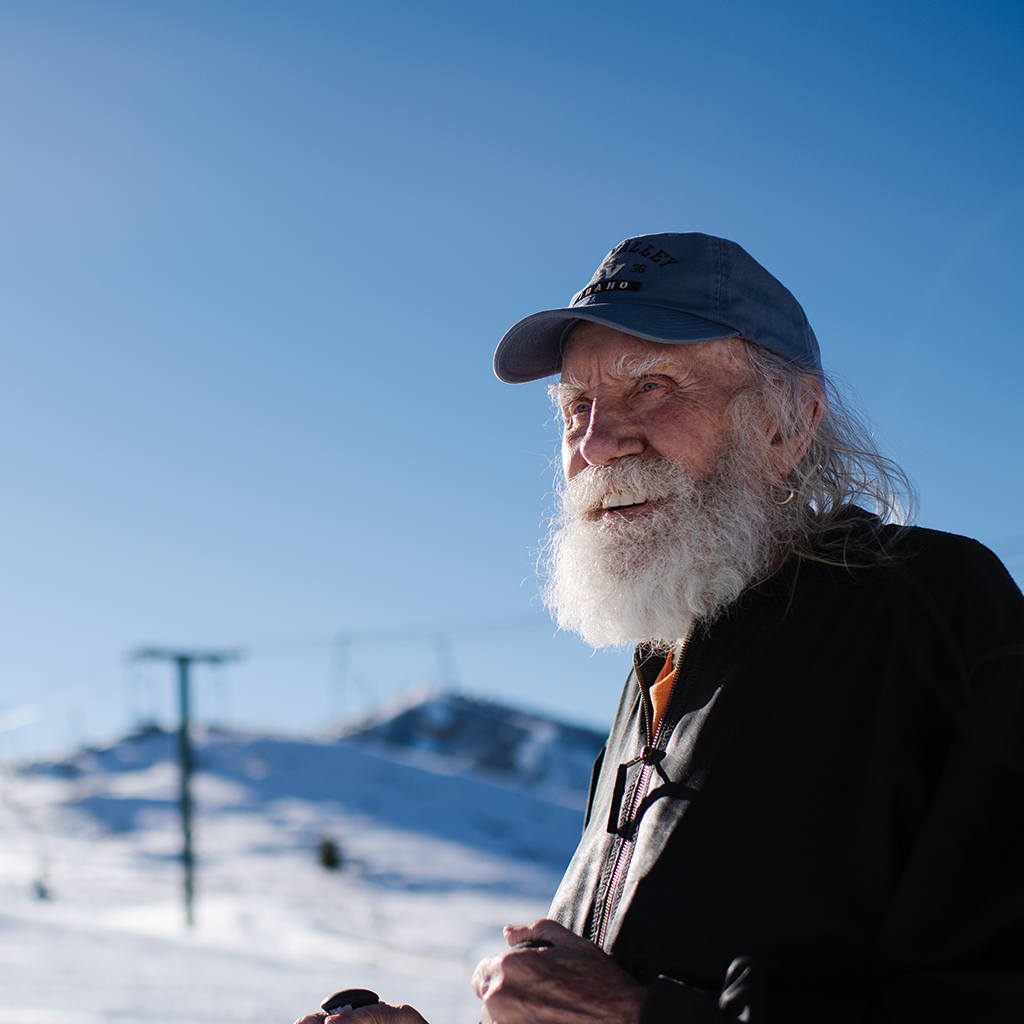Bobbie Burns is 84 years old, has made Sun Valley his home for more than 60 years, and is an iconic member of its community of skiers. This fall he was elected to the U.S. Ski and Snowboard Hall of Fame Class of 2020, a long overdue recognition of his pioneering contributions to freestyle skiing as an athlete, innovative designer of skis for ski racers at Seattle’s K2, and for his work designing and manufacturing freestyle skis like no others for his own company, The Ski, based in Sun Valley.
Born in Idaho and raised in Ogden and Salt Lake City, Utah, Burns did not grow up skiing, though he was always an outstanding athlete. In his younger years he mastered ballet, gymnastics and platform and springboard diving. He didn’t ski until he was in his early 20s and shortly after discovering the sport, moved to Sun Valley in those Averell Harriman days when lift passes, room and board were part of the package for some jobs with the Sun Valley Company. Burns was one of many ski bums who began his career there. He skied each day and worked at night, and with his long white-blond hair, bright blue eyes, and huge smile, he was hard to miss.
Burns told Matt Hansen for Powder Magazine that because of his dancing and diving background in which the body follows the head and eyes, “I found that I could ski huge bumps while standing up straight, but with ankle pressure, and be able to keep my balance with my head and my eyes.” That discovery defined Bobbie’s skiing technique and revolutionized (some might say ‘invented’) freestyle skiing.
Burns enjoyed skiing bumps with a higher balance point than skiers of more traditional techniques, and absorbed bumps better by holding his hands and arms above his head rather than in front of his torso. He said of his skiing in those years, “I was an accident waiting for a place. The only thing I had was a lot of guts, balance, and the ability to have fun.”
Accent on having fun.
By the mid 1960s he was revolutionizing the techniques of bump skiing, the concept of free skiing and the possibilities of steel thighs, noodle knees, balance and showmanship in skiing. With his long, blonde hair, unorthodox technique, unbelievable athleticism and huge smile Burns changed the world of performance skiing, in some ways simply because he was having more fun than everyone else. He has described his skiing style as “…different because I had large cojones but no ability.”
Ski cinematographer Dick Barrymore saw Bobbie skiing bumps in Sun Valley and remembered, “The sight changed my life as a filmmaker. Burns’ style was not like any I had seen before….Burns attacked a field of moguls like Errol Flynn attacking a band of pirates,” said Barrymore. “When he skied bumps, he sat down in a permanent toilet-seat position, with his arms high over his head holding 60 inch long ski poles….Bob Burns was, in 1969, the first hot dogger.”
Barrymore’s films introduced Burns’ skiing to the world, and…..the rest is history.
In the mid-‘60s Chuck Ferries, one of America’s great ski racers, was coaching the U.S. Women’s Ski Team and invited Burns to help him, more for his knowledge of skis and people than for his expertise in racing. Burns has said, “Racing was never for me.” In 1968 Ferries went to work for K2 Skis and convinced Burns to come with him‑‑‑to make skis. Burns said, “I didn’t know shit about skis,” but, then, there had been a time when he knew nothing about skiing. He moved to Seattle, studied for a graduate degree in chemical engineering at UW and learned how to make skis. In 1969 Marilyn Cochran became the first American to win a world cup title (in giant slalom), and Mike Lafferty, Spider Sabich and Bob Cochran (among several others) went on to successful ski racing careers on K2 skis designed by Bobbie Burns.
But Burns wanted to make skis for the way he liked to ski, not for racing. In 1974 Burns returned to Sun Valley and began making The Ski, the first ski, according to Burns, ever made in the Wood River Valley. The Ski revolutionized free skiing for the masses in much the same way as Bobbie Burns revolutionized free skiing for elite athletes of performance skiing. The Ski was soft lengthwise and stiff torsionally with simple blocks of color for artwork unlike anything seen in skiing before. In the mid-80s Burns sold his company. Since then he has made skis for select customers, designed clothes, taught skiing, worked as a consultant, raised his three daughters (aged 34, 19 and 13) and until a couple of years ago skied most days. He still dotes on his daughters and two infant grandchildren and hikes in summer on Proctor and Bald Mountains and walks in winter between Sun Valley and Ketchum. He can often be found in the coffee shop at Ketchum’s City Market holding court for his many old and new friends and fans. His hair is white (sometimes supported by a beard) instead of white-blonde, but his smile is as bright and mischievous as ever.


